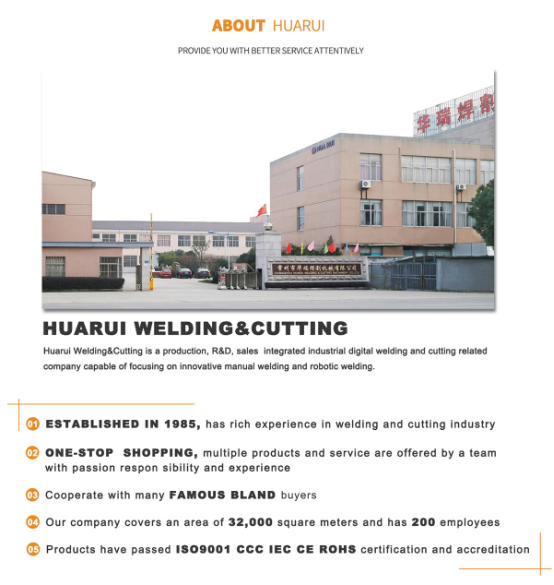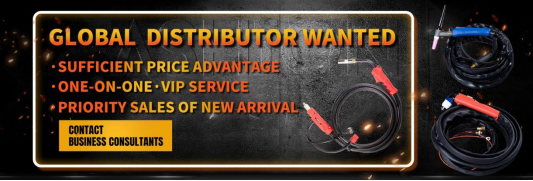- Welcome To Changzhou Huarui Welding & Cutting Machinery Co., Ltd.!
- About Huarui | Inquiry Form | Contact Us |
 中文
中文
 中文
中文At present, the most commonly used welding methods are solid cored wire gas welding (GMAW) and flux cored wire gas welding (FCAW). For carbon steel and low alloy steel, the main gas used in GMAW is argon (Ar)+ carbon dioxide (CO2), and the main gas used in FCAW is 100% carbon dioxide (CO2). It is found that FCAW is more prone to cold crack than GMAW. In order to verify the above inference, we carried out relevant experiments. First of all, we use the method of measuring diffused hydrogen of fused metal, and study the influence of different welding methods, welding parameters and gas on diffused hydrogen of fused metal. Secondly, the influence of diffused hydrogen content on the cold crack was studied by the inclined Y-groove welding crack test.
Experimental content and results of diffused
hydrogen determination of fused metal
The welding sample includes the front and rear two priming, arc extinguishing test block and the formal sample in the middle. The sample material was composed of carbon steel. The intermediate sample was treated with hydrogen at 650C for 1 hour and then cooled in an inert atmosphere. Then the intermediate sample was weighed with an accuracy of 0.01g. Store in a clean, dry container. The welding methods were GMAW and FCAW. For GMAW, we used gas Arcal 5, Arcal 21 and welding wire ER70S-6. For FCAW, 100% carbon dioxide (CO2) is used as gas, and E71T-1 low hydrogen flux-cored wire with diffused hydrogen content of H4 and H8 is used as welding wire, respectively. Welding equipment adopts automatic welding trolley, in order to ensure the comparability of the test, the welding environment must be controlled constant temperature and humidity. Before welding, we need to purge the welding pipeline for half an hour to ensure that there is no moisture adsorption in the gas pipeline. In addition, the dew-point meter is used to measure the dew-point at the outlet of different gas cylinders to master the moisture content of the above different gases. The welding mode is non-swing welding, and the welding parameters must be 4g+-0.5g of molten metal. Immediately after the welding (within 3-5s), place the welding sample in the ice-water mixture for 20 seconds, and then store the sample in the dry ice alcohol solution or liquid nitrogen below -78C. Before performing the diffused hydrogen content test, clean the intermediate sample with acetone or alcohol solution and quickly dry it with cold air. It is then placed in a collector as shown in the figure and argon gas is added to isolate the sample. The collector was placed in a heating furnace at 45℃ for 72 hours to collect diffused hydrogen from the central sample. Finally, the content of diffused hydrogen was measured by gas image chromatography.
The test results show that:
1) The diffused hydrogen content of fused metal using FCAW is significantly higher than that of solid cored gas shielded welding (GMAW). The main reason is that we believe that the water contained in some raw materials (such as rutile and fluorite) of powder inside the flux-cored wire exists in the form of crystal water. These crystalline waters have strong ion-dipole interaction and can remain stable below 1000C. When under the action of an electric arc, it breaks down into atomic hydrogen and enters the molten metal.
2) For gas shielded welding of solid cored wire, the diffused hydrogen content of fused metal with short circuit transition is lower than that of fused metal with jet transition. The main reason is that compared with the injection transition, the short circuit transition has a shorter arc length, and the contact range between the atmospheric water and the arc around the arc is smaller, which will produce less hydrogen atoms to dissolve into the molten metal.
3) For gas shielded welding with solid cored wire, the content of diffused hydrogen of cladding metal decreases with the increase of CO2 in gas. The main reason is that CO2 is decomposed into oxygen atoms under the action of electric arc, and oxygen atoms in the atmosphere of electric arc combine with hydrogen atoms, thus reducing the number of hydrogen atoms entering the interior of the fused metal.
Experimental content and result of welding crack of inclined Y groove
It is known from the above experiments that FCAW has a higher diffused hydrogen content in fused metal than GMAW. Whether the more diffused hydrogen content, the more likely to cause cold crack? Now let's look at the following experiment.
The sample is a sample of inclined Y-groove welding crack. The material is low carbon steel and the plate thickness is 25mm. The middle groove is inclined Y groove, and the two slope mouths are X groove. Before the formal welding test, it is necessary to complete the welding of X groove on both sides. The weld shall be 100% fully permeable. The weld can also be called constrained weld, whose purpose is to make the intermediate formal weld receive greater restraint during welding. Formal welds only require one weld.
We are going to use three samples.
Sample ① : Welding method is GMAW, gas is Arcal 5;
Sample ② : The welding method is GMAW, and the gas is Arcal 21;
Sample ③ : The welding method is FCAW, and the gas is 100%CO2.
The welding parameters shall be consistent with those used in the diffused hydrogen content test.
When PT test (penetration test) was carried out on the surface weld, it was found that cracks had appeared on the surface of the weld using FCAW (there was a purple line in the middle of sample ③, where was the crack). Therefore, it can be shown from the test that the sensitivity of cold crack is proportional to the content of diffused hydrogen in the weld.



 master@huarui-cn.com
master@huarui-cn.com 86-519-86371071
86-519-86371071 86-519-86371072
86-519-86371072
View More(Total0)Comment Lists